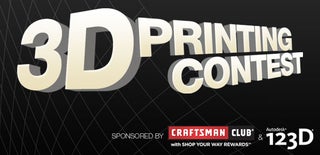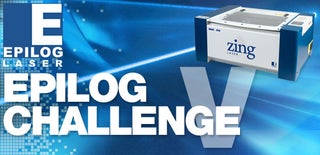Introduction: 3D Printed Photograph
By varying the thickness of a region of this semitransparent print you can control the amount of light that is able to pass through, thereby controlling the brightness (thinner regions of material will appear brighter and thicker regions darker). In this project, I've converted each individual greyscale pixel of an image to thickness, allowing me to precisely reproduce any greyscale image. The photos I've printed include an adorable picture my mom took of our cat Teddy (fig 4), Saturn and its moon Titan taken by the Cassini space probe (fig 5 and 6), and a huge print (19x16") of Mt. Williamson by Ansel Adams (fig 1, 2, and 3).
Step 1: The Code
All of these 3D models were generated algorithmically from Processing using the ModelBuilder library by Marius Watz. This library allows you to save 3D geometries in the STL file format, STL files that form a watertight mesh can be printed by a 3D printer.
To get started using this code yourself, download the latest version of the ModelBuilder library, unzip the file, and copy the folder into Processing's "libraries" folder. If you have installed the predecessor to the ModelBuilder library (called the Unlekker library), you will need to delete it. Once this is done restart Processing.
//image to 3d printable heightmap/lithophane
//by Amanda Ghassaei
//May 2013
//https://www.instructables.com/id/3D-Printed-Photograph/
/*
* This program is free software; you can redistribute it and/or modify
* it under the terms of the GNU General Public License as published by
* the Free Software Foundation; either version 3 of the License, or
* (at your option) any later version.
*/
//libraries
import processing.opengl.*;
import unlekker.util.*;
import unlekker.modelbuilder.*;
import ec.util.*;
String name = "your_file_name_here.jpg";//name of file (with extension - this also works with pngs)
//storage for dimensions
int widthRes;
int heightRes;
float widthDim = 5;//width dimension (in inches)
float widthScaled;
float heightScaled;
float zDim = 0.1;//max vertical displacement (in inches)
float thickness = 0.02;//base thickness (in inches)
boolean invert = true;//if true, then white areas are lower than black, if not true white areas are taller
PImage img;//storage for image
float pixeldata[];//storage for pixel array
UVertexList v1,v2,v3,v4;//storage for verticies
UGeometry geo;//storage for stl geometry
void setup(){
img = loadImage(name);//load image
//get dimensions of image
widthRes = img.width;
heightRes =img.height;
size(widthRes,heightRes,P3D);//set dimensions of output
image(img, 0,0);//display image
loadPixels();//poad pixels into array
pixeldata = new float[widthRes*heightRes];//initialize storage for pixel data
for(int index=0;index<widthRes*heightRes;index++){
int getPixelData = pixels[index];//get data from pixels[] array
pixeldata[index] = getPixelData&255;//convert to greyscale byte (0-255)
}
//initialize storage for stl
geo = new UGeometry();
v1 = new UVertexList();
v2 = new UVertexList();
v3 = new UVertexList();
v4 = new UVertexList();
//draw stl
if(invert){
//draw top
for(int i=0;i<(heightRes-1);i++){
v1.reset();
v2.reset();
for(int j=0;j<widthRes;j++){
widthScaled = j/float(widthRes)*widthDim;
//top layer
v1.add(widthScaled,i/float(widthRes)*widthDim,(255-pixeldata[widthRes*i+j])*zDim/255+thickness);
v2.add(widthScaled,(i+1)/float(widthRes)*widthDim,(255-pixeldata[widthRes*(i+1)+j])*zDim/255+thickness);
}
geo.quadStrip(v1,v2);
}
//draw sides
v1.reset();
v2.reset();
v3.reset();
v4.reset();
for(int j=0;j<widthRes;j++){
widthScaled = j/float(widthRes)*widthDim;
v1.add(widthScaled,0,(255-pixeldata[j])*zDim/255+thickness);
v2.add(widthScaled,0,0);
v3.add(widthScaled,(heightRes-1)/float(widthRes)*widthDim,(255-pixeldata[widthRes*(heightRes-1)+j])*zDim/255+thickness);
v4.add(widthScaled,(heightRes-1)/float(widthRes)*widthDim,0);
}
geo.quadStrip(v2,v1);
geo.quadStrip(v3,v4);
//draw sides
v1.reset();
v2.reset();
v3.reset();
v4.reset();
for(int i=0;i<heightRes;i++){
heightScaled = i/float(widthRes)*widthDim;
v1.add(0,heightScaled,(255-pixeldata[widthRes*i])*zDim/255+thickness);
v2.add(0,heightScaled,0);
v3.add((widthRes-1)/float(widthRes)*widthDim,heightScaled,(255-pixeldata[widthRes*(i+1)-1])*zDim/255+thickness);
v4.add((widthRes-1)/float(widthRes)*widthDim,heightScaled,0);
}
geo.quadStrip(v1,v2);
geo.quadStrip(v4,v3);
}
else{
//draw top
for(int i=0;i<(heightRes-1);i++){
v1.reset();
v2.reset();
for(int j=0;j<widthRes;j++){
widthScaled = j/float(widthRes)*widthDim;
//top layer
v1.add(widthScaled,i/float(widthRes)*widthDim,(pixeldata[widthRes*i+j])*zDim/255+thickness);
v2.add(widthScaled,(i+1)/float(widthRes)*widthDim,(pixeldata[widthRes*(i+1)+j])*zDim/255+thickness);
}
geo.quadStrip(v1,v2);
}
//draw sides
v1.reset();
v2.reset();
v3.reset();
v4.reset();
for(int j=0;j<widthRes;j++){
widthScaled = j/float(widthRes)*widthDim;
v1.add(widthScaled,0,(pixeldata[j])*zDim/255+thickness);
v2.add(widthScaled,0,0);
v3.add(widthScaled,(heightRes-1)/float(widthRes)*widthDim,(pixeldata[widthRes*(heightRes-1)+j])*zDim/255+thickness);
v4.add(widthScaled,(heightRes-1)/float(widthRes)*widthDim,0);
}
geo.quadStrip(v2,v1);
geo.quadStrip(v3,v4);
//draw sides
v1.reset();
v2.reset();
v3.reset();
v4.reset();
for(int i=0;i<heightRes;i++){
heightScaled = i/float(widthRes)*widthDim;
v1.add(0,heightScaled,(pixeldata[widthRes*i])*zDim/255+thickness);
v2.add(0,heightScaled,0);
v3.add((widthRes-1)/float(widthRes)*widthDim,heightScaled,(pixeldata[widthRes*(i+1)-1])*zDim/255+thickness);
v4.add((widthRes-1)/float(widthRes)*widthDim,heightScaled,0);
}
geo.quadStrip(v1,v2);
geo.quadStrip(v4,v3);
}
//draw bottom
v1.reset();
v2.reset();
//add bottom four corners
v1.add(0,0,0);
v1.add(0,(heightRes-1)/float(widthRes)*widthDim,0);
v2.add((widthRes-1)/float(widthRes)*widthDim,0,0);
v2.add((widthRes-1)/float(widthRes)*widthDim,(heightRes-1)/float(widthRes)*widthDim,0);
geo.quadStrip(v1,v2);
//change extension of file name
int dotPos = name.lastIndexOf(".");
if (dotPos > 0)
name = name.substring(0, dotPos);
geo.writeSTL(this,name+".stl");
exit();
println("Finished");
}
Download the latest version of the Processing sketch from GitHub (download as a zip by clicking on the cloud button). Open the folder called Lithograph3DPrint. Copy any greyscale images you want to convert into this folder.
To run the sketch, replace the part in quotes in following line:
String name = "your_file_name_here";
with the name of your greyscale image. I believe .gif, .jpg, .tga, and .png files will all work fine, but I have only tested .jpg so far. Run the sketch, after a minute or two Processing will tell you that it is writing an STL file and eventually it will tell you that it is finished. The resulting file will be located in the sketch's folder named "NAME_OF_ORIGINAL_FILE.stl" You can open the stl file with a variety of CAD software and stl viewers, I like MeshLab for simple viewing (it's free and open source).
By default my sketch will scale images to 8" wide, with a base thickness of 0.02" and feature thickness of up to 0.1", you can change these setting by adjusting the variable at the top of the sketch.

Participated in the
3D Printing Contest

Participated in the
Epilog Challenge V











